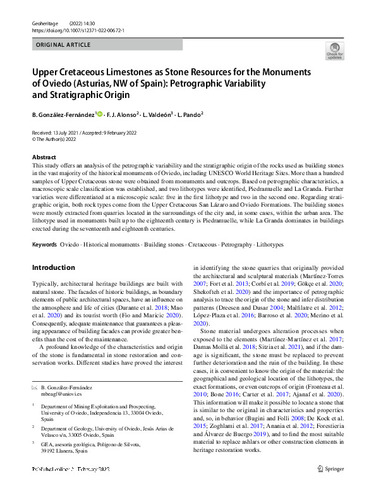Upper Cretaceous limestones as stone resources for the monuments of Oviedo (Asturias, NW of Spain): Petrographic variability and stratigraphic origin
Palabra(s) clave:
Oviedo, historical monuments, building stones, cretaceous, petrography, lithotypes
Fecha de publicación:
Editorial:
Springer
Versión del editor:
Citación:
Resumen:
This study ofers an analysis of the petrographic variability and the stratigraphic origin of the rocks used as building stones in the vast majority of the historical monuments of Oviedo, including UNESCO World Heritage Sites. More than a hundred samples of Upper Cretaceous stone were obtained from monuments and outcrops. Based on petrographic characteristics, a macroscopic scale classifcation was established, and two lithotypes were identifed, Piedramuelle and La Granda. Further varieties were diferentiated at a microscopic scale: fve in the frst lithotype and two in the second one. Regarding strati graphic origin, both rock types come from the Upper Cretaceous San Lázaro and Oviedo Formations. The building stones were mostly extracted from quarries located in the surroundings of the city and, in some cases, within the urban area. The lithotype used in monuments built up to the eighteenth century is Piedramuelle, while La Granda dominates in buildings erected during the seventeenth and eighteenth centuries
This study ofers an analysis of the petrographic variability and the stratigraphic origin of the rocks used as building stones in the vast majority of the historical monuments of Oviedo, including UNESCO World Heritage Sites. More than a hundred samples of Upper Cretaceous stone were obtained from monuments and outcrops. Based on petrographic characteristics, a macroscopic scale classifcation was established, and two lithotypes were identifed, Piedramuelle and La Granda. Further varieties were diferentiated at a microscopic scale: fve in the frst lithotype and two in the second one. Regarding strati graphic origin, both rock types come from the Upper Cretaceous San Lázaro and Oviedo Formations. The building stones were mostly extracted from quarries located in the surroundings of the city and, in some cases, within the urban area. The lithotype used in monuments built up to the eighteenth century is Piedramuelle, while La Granda dominates in buildings erected during the seventeenth and eighteenth centuries
Notas Locales:
OA ATUO22
Ficheros en el ítem





